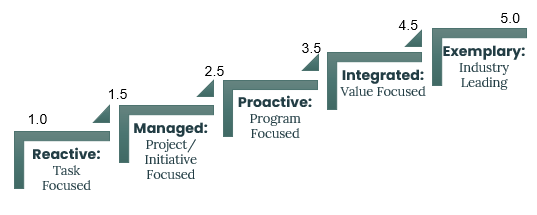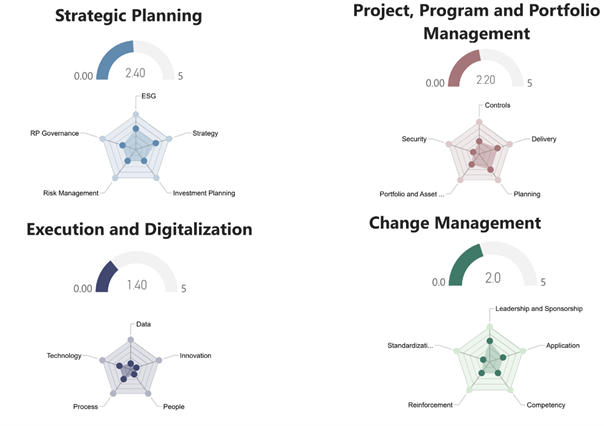
Over the past year, our Real Property Advisory team spoke to many public sector leaders who are struggling to prioritize adaptability, sustainability, and resiliency amidst the current geopolitical and economic instability.
“People are overwhelmed,” one public sector executive remarked, “and when people get overwhelmed, they struggle to make effective, value-based decisions.”
This difficulty in decision-making often stems from a lack of organizational maturity, as many organizations do not yet have the capabilities needed to implement their desired strategies—especially in challenging times.
To help public organizations make more informed choices, we created a way for portfolio managers to mature their operations in an evolving climate, enabling their teams to better capitalize on opportunities when they arise.
The result is Tiree’s Organizational Maturity Model (TOMM), which draws on 25 years of public sector experience. TOMM helps portfolio managers and public organizations close maturity gaps, reduce uncertainty, and make confident, value-based decisions about their real property portfolios.
In this blog, we’ll also outline what organizational maturity is, why it matters to the public sector, and how to position real property as a strategic function within your organization.
Contents
Real property teams in the public sector play a vital role by providing the spaces that support service delivery.
To fulfill this mandate, real property teams are responsible for developing portfolio strategies, executing real estate transactions, supporting major construction projects, and overseeing the management and maintenance of the organization’s real property portfolio.
Real property is typically a department within a larger public sector organization and may also be referred to as corporate real estate or asset management. Responsibilities often include property management, asset planning, leasing, capital projects, facilities operations, and strategic real estate planning.
Organizational maturity is a measure of how well the structures, processes, and capabilities of an organization support its ability to operate efficiently, adapt to change, and achieve strategic objectives. Mature organizations are proactive, data-informed, resilient, and able to capitalize on new opportunities, manage risk, and drive continuous improvement.
Less mature organizations may operate in silos with limited insight into organizational plans, rely on undocumented processes, and react to challenges rather than anticipate and mitigate them.
For real property teams in the public sector, organizational maturity ensures that you can capitalize on new opportunities in a timely manner, while also mitigating risk. These opportunities may be specific to real property but can also lead to more innovative and efficient processes organization-wide.
Research by Cognizant found that maturity models in areas like portfolio management and procurement are shown to enhance efficiency, cost control, and strategic alignment.
For mature public sector organizations, transparent, repeatable, and evidence-based processes support public accountability and effective leadership. These processes are necessary for continued funding, approvals, and resource support from federal, provincial, and municipal governments.
Public sector organizations must also make long-term infrastructure commitments. A high level of maturity ensures these commitments can be honoured without affecting service delivery in other areas.
Similarly, many public sector organizations are faced with budget and procurement constraints. In mature organizations, these limitations aren’t a hurdle, but rather an opportunity to identify how to leverage existing resources for better financial stewardship and asset management.
Simplifying interdepartmental complexity is another advantage of improving organizational maturity. Public sector organizations often have hierarchical departments (including real property) that function independently. Maturity ensures that all departmental activities align with strategic goals.
These benefits reflect the importance of organizational maturity in the public sector. An organizational maturity model, as described in the next section, helps you effectively evaluate and improve your maturity.
An organizational maturity model is a structured framework used to assess how developed an organization is across key domains. Maturity models provide a baseline for evaluation and identify areas for improvement. Their consistent use can help organizations pursue higher levels of performance.
As part of our extensive public sector research, we identified three common types of organizational maturity models:
Some models serve a single purpose, while other models are a blend of types. No matter which model you choose, you should prioritize finding a framework that best serves your organization’s needs, based on your short- and long-term objectives.
However, it’s important to keep in mind that organizational maturity models have some limitations.
While organizational maturity models can be helpful diagnostic tools, it’s important to understand their limitations to avoid overreliance or misapplication.
Organizations are made up of people and people are complex. Any attempt to simplify organizations to a level of maturity may lead to oversimplification. For example, in highly siloed organizations experiencing entrenched animosity or competitiveness between departments, reaching an “integrated” maturity level may be more difficult than in an organization without these silos, even if both organizations are operating at the same level of maturity.
In self-assessed maturity models, there is often a level of subjectivity and ambiguity. Each of us has our own biases and innate levels of optimism or pessimism, which can skew results. To reduce this limitation, focus on empirical facts where available and identify areas of consensus to help counteract individual bias.
Another criticism of organizational maturity models is their tendency to push maturity for maturity’s sake. Not all organizations need to be at the same level of maturity in all domains. Maturity should always be related back to your organization’s strategic goals—what do you want to achieve by maturing? How will maturing help you reach your goals? Are these goals (and the investment in maturity needed to achieve them) realistic and achievable? Maturing will only benefit your organization if there is a purpose behind your actions.
In prescriptive models, there is little room for experimentation. There is also the perception that growth is always linear, but this isn’t necessarily true, especially during times of disruption like we’re facing now. It’s important to understand why you’re doing something, but also how it will impact the broader organization, regardless of whether it’s in alignment with the next maturity stage. Maturity models are tools, not prescriptions, for identifying gaps in your organization’s processes, structure, and capabilities.
Overall, it’s important to understand the type and limitations of your maturity model before implementing it at your organization.
Recognizing the need for a more flexible, strategic approach, we developed Tiree’s Organizational Maturity Model. Drawing on 25 years of public sector experience, TOMM gives real property teams the insights needed to identify opportunities across four key domains or adapt the model to their specific context.
Tiree’s Organizational Maturity Model focuses on public real property organizations. The tool specifically homes in on the four functional areas our public sector partners have struggled with most in recent years, as they’ve been pushed to adapt in the face of rapidly evolving technologies and shifting geopolitical and economic conditions.
Our experts reviewed the many recent gap analyses and strategies we’d developed for our public sector partners to identify the most common organizational gaps. Through this exercise we identified four key domains currently affecting real property teams. They include:
We then assembled a team of experts in each of these domains—strategy advisors; portfolio and project managers; digitalization experts; and change leaders—to review 30 different maturity models before creating Tiree’s Organizational Maturity Model.
Our model is informed by our 25-year tenure in the public sector, where we’ve helped our clients deliver over $50 billion in real property projects. TOMM combines best practices from several existing frameworks to address the specific challenges faced by portfolio managers in the public sector. Unlike generic maturity models, TOMM is purpose-built for public sector portfolio managers navigating complex asset portfolios, policy constraints, and the shifting mandates of today’s uncertain environment.
Tiree’s Organizational Maturity Model defines the five stages of organizational maturity as:

Let’s look at an example of how to apply Tiree’s Organizational Maturity Model to a federal organization planning to launch a new departmental strategy.
Based on trends we’ve observed across multiple federal organizations, we created a representative scenario of a public sector organization trying to identify the biggest risks of a new strategy and determine where leadership support is needed to advance this initiative.
Prior to completing the assessment, the organization identified four strategic goals (referred to below as SG1, SG2, SG3, and SG4) that are tied closely to their new departmental strategy: strengthening capacity, enhancing governance, ensuring compliance, and advancing leadership.
Using TOMM, the organization evaluated each of their strategic goals against the four domains: strategic planning; project, program, and portfolio management; execution and digitalization; and change management. For each domain, subject-matter experts assessed performance across five key focus areas using descriptive criteria tied to each maturity stage.
Below are the results from TOMM, with each of the four domains broken down into five key focus areas. The half-gauge chart shows where the organization sits on the maturity scale (a score out of 5), and the spider graphs show how mature the organization is in each of the five focus areas. These results show an organization at the “Managed” level of maturity—but is that enough to support a new departmental strategy launch?

A “Managed” level of maturity means that the organization can effectively operate at the project- or initiative-level within most domains. With a score of 1.40/5, execution and digitalization maturity is mostly reactive instead of proactive, which is reflective of ad hoc data gathering and reporting processes that are not well documented.
To implement the new strategy at the program, portfolio, or department level, the organization will likely need to mature, but where should the department focus its efforts?
To find out, the organization compared their current state of maturity against what’s required to achieve their goals and charted where gaps existed within each goal—the results of which are shown below.
Green areas indicate sufficient maturity to move forward, while red areas highlight gaps that could pose risks to strategy delivery. In this case, weak execution and digitalization pose risks to the success of all the strategic goals, but especially for capacity and leadership. This domain should be a priority for the organization in the short-term, as it will impact all future activities.
The results also indicate that the organization must mature to achieve their desired leadership position within the timeframe allotted, which will need buy-in from executive leaders. Capacity building is also at risk and will require support at the strategic level to ensure the goal can be achieved.

The organization’s leadership team should consider whether they can mature at the rate they’ve set out in their plan, whether the maturity gaps pose significant risks, and if so, how to mitigate them, and how timelines will be impacted.
By identifying these gaps early, the organization can either adjust timelines, secure additional resources, or recalibrate expectations, turning insights into an actionable strategy.
With the strategy still in development, these results give leadership a valuable opportunity to align stakeholder expectations early—before execution begins. This methodical approach can help reduce uncertainty and improve decision-making for portfolio managers when executing new strategies.
When applying Tiree’s Organizational Maturity Model to your organization, our team can customize the model to your specific goals and context. You can define each of the strategic goals within the four domains, with the potential to specify the five focus areas of each goal.
This flexibility allows you to apply TOMM to a wide variety of real property challenges in an era of uncertainty and unpredictability.
Organizational maturity models can be a great starting point for identifying gaps in your capabilities, processes, and systems. When leveraged in the context of your organizational KPIs and strategy, you can assess the value of maturing based on what you want to accomplish.
As such, organizational maturity should always be considered within the context of your data and goals, considering questions like: What is your data telling you? What is industry-specific data indicating? What are your people telling you? And what’s your strategy telling you?
Only then can you begin to identify what actions are needed to improve your maturity. The inherent risk isn’t always a low level of maturity, but maturity models can help you pinpoint whether you need to improve your maturity in key areas, like strategic planning, for example, before you can realistically achieve your goals.
It’s also important to keep in mind that maturity is an iterative process. Once you make improvements, you should re-evaluate your maturity, using your results as a guide towards a more efficient and effective real property function.
Throughout this process, you should also involve as many stakeholders as possible. This way, everyone within your organization can better understand the synergies between their focus areas (e.g., real property) and how they affect performance.
Whether you’re looking to improve your asset management, capitalize on new opportunities, or mitigate risk, organizational maturity models can give you insight into gaps in your real property strategy and how to prioritize next steps.
Tiree’s Organizational Maturity Model has been purpose-built for portfolio managers in the public sector, focusing on the areas of strategic planning; project, program, and portfolio management; execution and digitalization; and change management.
Measure your public sector organization’s maturity with Tiree’s Organizational Maturity Model today.
Looking for a more personalized approach to organizational maturity? Get in touch with our experts to create a custom-built model that’s specific to your organization’s goals.
